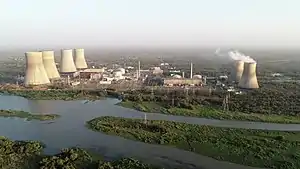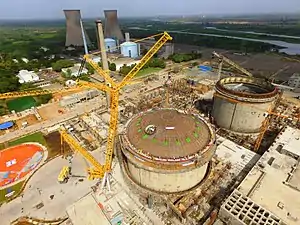Kakrapar Atomic Power Station
Kakrapar Atomic Power Station is a nuclear power station in India, which lies in the proximity of Mandvi, Surat and Tapi river in the state of Gujarat.
| Kakrapar Atomic Power Station | |
|---|---|
 | |
| Country | India |
| Coordinates | 21°14′19″N 73°21′00″E |
| Status | Operational |
| Construction began | 1984 |
| Commission date | 6 May 1993 |
| Operator(s) | Nuclear Power Corporation of India |
| Nuclear power station | |
| Reactors | 3 |
| Reactor type | |
| Reactor supplier | NPCIL/BARC |
| Cooling source | Ukai Dam, Tapti River |
| Power generation | |
| Units operational | 2 × 220 MW 1 × 700 MW |
| Units under const. | 1 × 700 MW |
| Nameplate capacity | 1034 MW |
| Capacity factor | 38.25% (5 year global average of 2 older units) |
| Annual net output | 1354 GW·h |
| External links | |
| Website | www |
| Commons | Related media on Commons |
Phase I
Phase I consist two 220 MW pressurised water reactor with heavy water as moderator (PHWR). KAPS-1 went critical on 3 September 1992 and began commercial electricity production a few months later on 6 May 1993. KAPS-2 went critical on 8 January 1995 and began commercial production on 1 September 1995. In January 2003, CANDU Owners Group (COG) declared KAPS as the best performing pressurised heavy water reactor.[1]
KAPS-2 was shut down after a coolant channel leak in July 2015 and a similar issue forced the shutdown of KAPS-1 in March 2016. After a replacement of coolant channels and feeder tubes, KAPS-2 attained criticality in September 2018. Maintenance on KAPS-1 was completed ahead of schedule and was brought to operation on 19 May 2019.[2]
The construction costs were originally estimated to be ₹382.52 crore; the plant was finally finished at a price of ₹1,335 crore.
Phase II
In 2007 the First Manmohan Singh ministry approved outline plans to build two Indian-designed IPHWR-700 reactors, with two sister reactors a little later at Rajasthan Atomic Power Station. In 2009 approval was confirmed, and site preparation was completed by August 2010. The first concrete for Kakrapar 3 and 4 was in November 2010 and March 2011 respectively with operation originally expected by early and late 2018 respectively.[3][4]
The project over-ran largely due to tuning of the IPHWR-700 design and slow delivery of supplies.[3]
Unit 3 achieved the first criticality on 22 July 2020. It was connected to the grid on 10 January 2021.[5] This unit began commercial operation on 30 June 2023.[6]
Unit 4 commissioning is under progress. Hot functional testing was scheduled around June 2023 and Unit 4 criticality was initially planned around September 2023. Unit 3 achieved operations at full load on 31 August 2023.[7] The Initial Fuel Loading (IFL) of Unit 4 commenced on 20 October 2023 after permission was granted by the Atomic Energy Regulatory Board.[8]
Units
| Unit | Type | Gross MW | Construction start | Operation start | Notes |
|---|---|---|---|---|---|
| Phase I | |||||
| Kakrapar 1 | IPHWR-220 | 220 | 1 December 1984 | 6 May 1993 | [9] |
| Kakrapar 2 | IPHWR-220 | 220 | 1 April 1985 | 1 September 1995 | [10] |
| Phase II | |||||
| Kakrapar 3 | IPHWR-700 | 700 | 22 November 2010 | 30 June 2023 | [11] |
| Kakrapar 4 | IPHWR-700 | 700 | 22 November 2010 | March 2024 (planned) | [12] |

Incidents
- 1998 KAPS-1 was switched off because of a leakage in the cooling loop for 66 days.
- 10 March 2004 the (at the time of) supply for the control rods were irreparably damaged during maintenance work. In response, poisons were added to the system and the reactor was shut off.
- On 22 August 2006 it was reported by village inhabitants the area around the power station had been penetrated. A search by the police did not result in any findings.
- On 11 March 2016, KAPS-1 automatically shut down due to a leak of heavy coolant water, leaving both reactors non-operational.[13][14] The leak was plugged ten days later.[15] Corrosion and cracks were found on the coolant channel and similar corrosion spots were found in KAPS-2 which had been non-operational since July 2015 after a coolant channel leak.[16][17] KAPS-2 attained criticality on 17 September 2018 after a replacement of its coolant channels and feeder tubes. KAPS-1 became operational ahead of schedule on 19 May 2019[2]
References
- Kurian, Vinson (26 March 2003). "Indian N-reactors set new global benchmark". The Hindu Business Line. Retrieved 16 February 2017.
- "KAPS-1 connected to grid" (PDF). NPCIL. Retrieved 24 May 2019.
- "Bright prospects for India's future fleet". Nuclear Engineering International. 16 August 2017. Retrieved 23 July 2020.
- "Kakrapar 3 achieves first criticality". World Nuclear News. 22 July 2020. Retrieved 23 July 2020.
- "Unit 3 of Kakrapar nuclear plant synchronised to grid". Live Mint. 10 January 2021. Retrieved 18 January 2021.
- "India's Kakrapar 3 begins commercial operation". World Nuclear News. 4 July 2023. Retrieved 25 July 2023.
- "Gujarat: 'India Achieves Another Milestone' As First Indigenous 700 MW Nuclear Plant Starts Operations At 100%". Free Press Journal. 31 August 2023.
- "NPCIL starts loading fuel in home-built 700 MW n-power plant at Kakrapar". ET EnergyWorld. 21 October 2023. Retrieved 21 October 2023.
- "Nuclear Power Reactor Details - KAKRAPAR-1". Power Reactor Information System. International Atomic Energy Agency (IAEA). 23 November 2010. Retrieved 23 November 2010.
- "Nuclear Power Reactor Details - KAKRAPAR-2". PRIS. (IAEA). 23 November 2010. Retrieved 23 November 2010.
- "India's first domestically built 700 MW nuclear reactor starts commercial operations in Gujarat". The Economic Times. 30 June 2023. ISSN 0013-0389. Retrieved 30 June 2023.
- Varadhan, Sudarshan (31 May 2022). "Operation of nuclear power unit in India's western Gujarat state delayed". Reuters.
- Harikumar, S. (11 March 2016). "Shutdown of Unit-1 of KAPS Nuclear Power Plant following an incident leakage from Coolant System" (PDF). aerb.gov.in. Retrieved 16 February 2017.
- "More than 100 hours later, Kakrapar nuclear leak not fixed". 16 March 2016. Retrieved 18 April 2016 – via Rediff.com.
- "Kakrapar Nuclear Reactors to Get New Coolant Channels". News18. Indo-Asian News Service. 1 February 2017.
- Fernandes, Snehal (19 March 2017). "A year after KAPS-1 heavy water leak, corrosion spots found: AERB". Hindustan Times.
- Balan, Premal (11 March 2017). "Ahmedabad: No power from Kakrapar plant for at least a year". The Times of India.
External links
- "Nuclear Power in India". Country Briefings. World Nuclear Association (WNA). November 2010. Retrieved 23 November 2010.